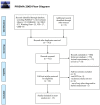Efficacy of Huangqi Injection in the Treatment of Hypertensive Nephropathy: A Systematic Review and Meta-Analysis
- PMID: 35547210
- PMCID: PMC9081808
- DOI: 10.3389/fmed.2022.838256
Efficacy of Huangqi Injection in the Treatment of Hypertensive Nephropathy: A Systematic Review and Meta-Analysis
Abstract
Background: Huangqi injection (HQI) is the extract of Astragalus membranaceus (Fisch.) Bunge, which is widely used in the treatment of a variety of diseases in China. It is supposed to be an important adjuvant therapy for hypertensive nephropathy.
Objective: To evaluate the efficacy of HQI combined with antihypertensive drugs in the treatment of hypertensive nephropathy.
Materials and methods: We systematically searched China National Knowledge Infrastructure (CNKI), Chinese Scientific Journals Database (VIP), Wanfang Knowledge Service Platform (WanfangData), Chinese Biomedical Database (CBM), EMBASE, PubMed and Cochrane Library from their inception to April 23st, 2021. All studies were independently screened by two auditors according to the inclusion and exclusion criteria. Randomized controlled trials comparing HQI in combination with antihypertensive drugs vs. antihypertensive drugs alone were extracted.
Results: The meta-analysis included 15 studies involving 1,483 participants.The effect of HQI combined with antihypertensive drugs is better than that of antihypertensive drugs alone in regulating hypertensive nephropathy for reducing 24-h urinary total protein (24 h UTP) [WMD=-0.29, 95% CI (-0.40, -0.18), P = 0.000], microalbuminuria (mALB) [WMD = -17.04, 95% CI (-23.14, -10.94), P = 0.000], serum creatinine (SCr) [WMD = -40.39, 95% CI (-70.39, -10.39), P = 0.008], systolic blood pressure (SBP) [WMD = -9.50, 95% CI (-14.64, -4.37), P = 0.000], diastolic blood pressure (DBP) [WMD = -4.588, 95% CI (-6.036, -3.140), P = 0.000], cystatin-C (Cys-c) [WMD = -0.854, 95% CI (-0.99, -0.72), P = 0.000], blood urea nitrogen (BUN) [WMD = -4.155, 95% CI (-6.152, -2.157), P = 0.000].
Conclusion: The combination of HQI and antihypertensive drugs is more efficient in improving the related indexes of patients with hypertensive nephropathy than using antihypertensive drugs alone, and a moderate dose of HQI (no more than 30 mL) may benefit more. However, the quality of the methodology is low and the number of samples is small, the results need to be confirmed by more stringent randomized controlled trials.
Keywords: Astragalus membranaceus (Fisch.) Bunge; Huangqi injection; hypertensive nephropathy; meta-analysis; systematic review.
Copyright © 2022 Xu, Qian, Niu, Yang, Liu and Lin.
Conflict of interest statement
The authors declare that the research was conducted in the absence of any commercial or financial relationships that could be construed as a potential conflict of interest.
Figures














References
Publication types
LinkOut - more resources
Full Text Sources
Miscellaneous

